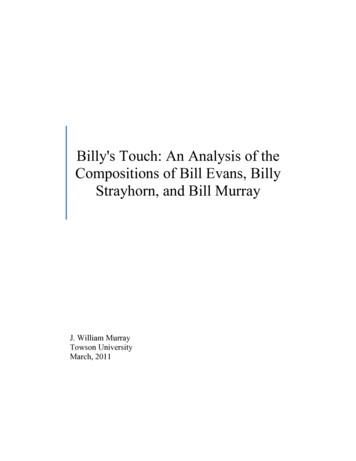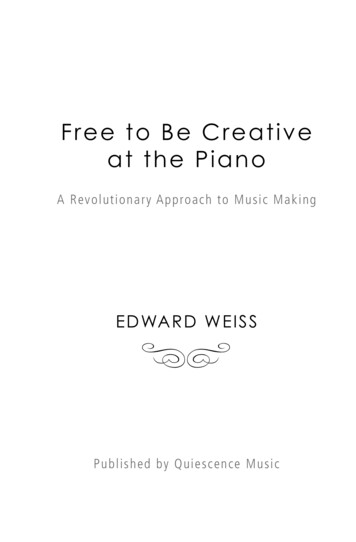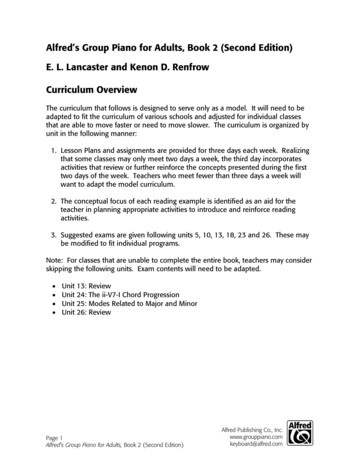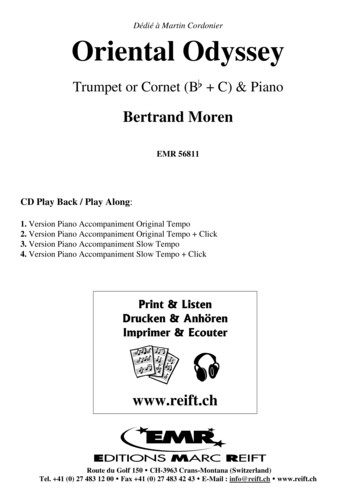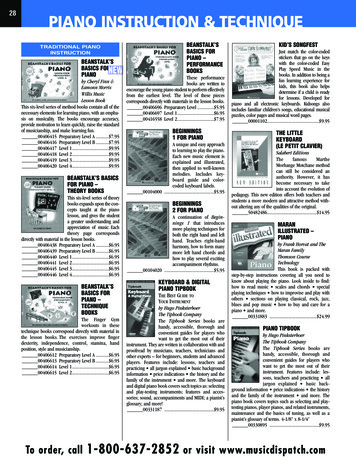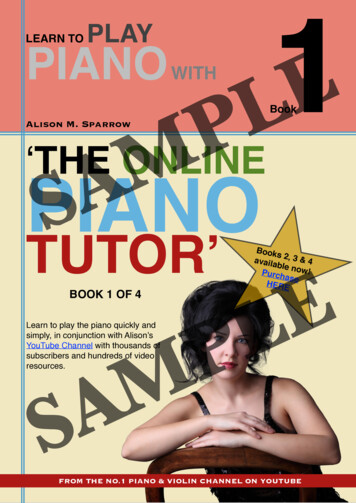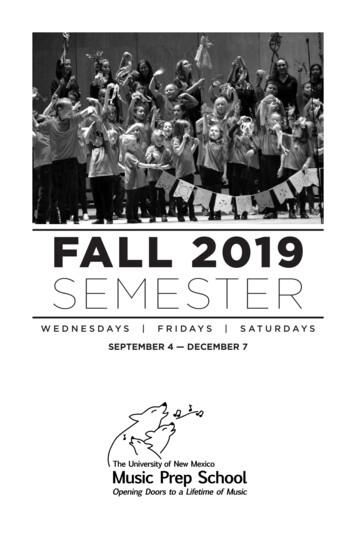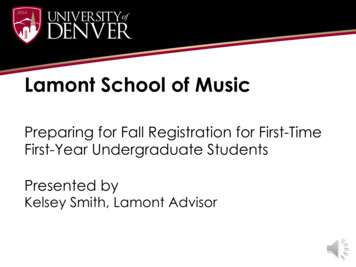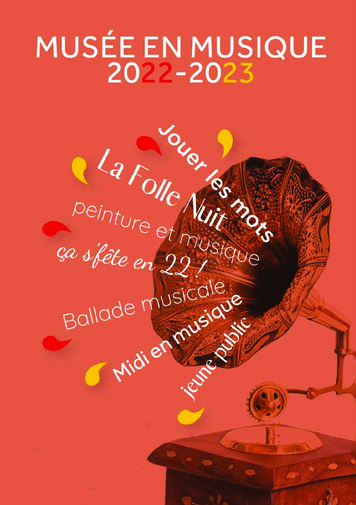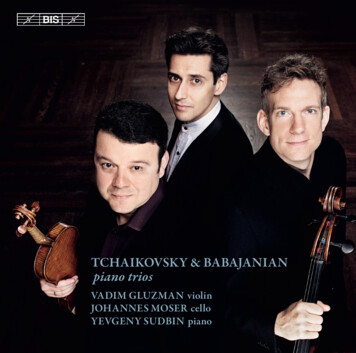
Transcription
TCHAIKOVSKY & BABAJANIANpiano triosVADIM GLUZMAN violinJOHANNES MOSER celloYEVGENY SUDBIN piano
TCHAIKOVSKY, Pyotr Ilyich (1840—93)Piano Trio in A minor, Op. 50 (1881—82)48'20à la mémoire d’un grand artiste1234567891011121314I. Pezzo elegiaco. Adagio con duolo e ben sostenutoII. A. Tema con variazioniTema. Andante con motoVariation IVariation II. Più mossoVariation III. Allegro moderatoVariation IV. L’istesso tempoVariation V. L’istesso tempoVariation VI. Tempo di valseVariation VII. Allegro moderatoVariation VIII. Fuga. Allegro moderatoVariation IX. Andante flebile, ma non tantoVariation X. Tempo di Mazurka. Con brioVariation XI. ModeratoB. Variazione Finale e CodaAllegro risoluto e con fuoco — Andante con moto — '111'512'1511'11
BABAJANIAN, Arno (1921—83)151617Piano Trio (1952) (Muzyka)I. Largo — Allegro espressivoII. AndanteIII. Allegro vivace21'308'376'545'48SCHNITTKE, Alfred (1934—98), arr. Yevgeny Sudbin18Tango from the opera Life with an Idiot (1992)(Sikorski)2'21TT: 73'21Vadim Gluzman violinJohannes Moser celloYevgeny Sudbin pianoJohannes Moser appears by kind permission of Pentatone.InstrumentariumViolin: Antonio Stradivari 1690, ‘ex-Leopold Auer’, on loan from the Stradivari Society of ChicagoCello: Andrea Guarneri, 1694, from a private collectionPiano: Steinway D3
Established more or less single-handedly by Joseph Haydn, the piano triogenre has in Russia become associated with a special tradition. It has almostassumed the character of an instrumental requiem, becoming a composition‘in memoriam’. This tradition started with Pyotr Ilyich Tchaikovsky’s Piano Trioin A minor, Op. 50 (1881–82), dedicated ‘to the memory of a great artist’ (referringto Nikolai Rubinstein); this was followed by such works as Anton Arensky’s PianoTrio in D minor, Op. 32 (1894, in memory of the cellist Karl Davidov), SergeiRachmaninov’s Trio élégiaque in D minor, Op. 9 (1893, in memory of Tchaikovsky)and Dmitri Shostakovich’s Piano Trio No. 2 in E minor, Op. 67 (1944, in memoryof the musicologist Ivan Sollertinsky). Most of these have titles or movement markings that contain the words ‘elegiac’ or ‘elegy’ – a concept that since Antiquity hasbecome increasingly similar to a ‘lament’. Grief may not have been a welcomesource of inspiration for the composers’ imagination, but it was evidently an inspiring one.Tchaikovsky must have chosen the instruments for his friend and mentor NikolaiRubinstein – pianist, conductor and director of the Moscow Conservatory – withparticular care. As recently as October 1880 he had replied to his patron Nadezhdavon Meck’s question about why he had not yet composed a piano trio: ‘How unnatural is the combination of violin, cello and piano! Each of the instruments losesits unique charm After all, a trio presupposes equality and homogeneity; howcan these exist between string instruments on one side and the piano on the other?They are lacking. Therefore piano trios always seem rather contrived.’Always? The composer’s friend Nikolai Kashkin wrote about the reasons whyTchaikovsky embarked on a piano trio just a year later: ‘Above all he regarded itas impossible to write a work in memory of a great pianist without allocating aleading role to the piano, and at the same time he found the concerto form, or thatof a fantasy with orchestra, to be too showy and overblown for the task he had set4
himself. On the other hand, a solo piano would have been insufficient to conveythe musical colours he had in mind ’And so this avowed opponent of the piano trio genre quickly changed his mind.But it had to be something exceptional: his piano trio, a musical obituary, is in twoparts, a Pezzo elegiaco (‘elegiac piece’) and a set of variations with further subdivisions. Right at the start the cello plays a moving lament, which sets the tone for theentire movement and will ultimately frame the whole trio in a cyclical manner. Inthis sonata-form movement it serves as the main theme, and is joined by a brighter,hymn-like subsidiary theme in the dominant, E major. The development concernsitself with motifs from the elegy, presents new thematic material and ultimately leadsto a recapitulation (Adagio con duolo e ben sostenuto), where the main theme is heard,as pale as a corpse. The set of variations in the second part is based on a Russian folksong; its subsequent metamorphoses represent – according to Kashkin – highlightsfrom the life and career of Nikolai Rubinstein. The theme is presented by the pianoand then taken over by the violin and cello (Var. 1 2), after which a kaleidoscopicarray of facets unfolds – from a gracious waltz (Var. 6) to a large-scale fugue (Var. 8),from a string lament (Var. 9) to a lively mazurka (Var. 10). Variation 11 with its pedalpoints is a moment of rest; here the music gathers its strength in readiness for theseparate final variation (B. Variazione finale e coda), which reinterprets the themerhythmically and, after reminiscences of the first part, culminates in the dramaticallyintoned lament from the Pezzo elegiaco – the time for cheerfulness is past. In thefuneral march, the trio’s opening theme is carried to the grave.The trio’s epic, wide-ranging structure has not always won it friends. For example the influential Viennese critic Eduard Hanslick wrote in 1899: ‘Tchaikovsky’sPiano Trio in A minor, Op. 50, has been played in Vienna for the first time; the facesof the audience almost expressed the hope that it would be the last.’ For Hanslickthe main reason for this was the ‘merciless’ length through which the trio robbed5
itself of any success it might deserve. One could take a different view – especiallyin a city that had already witnessed its share of ‘heavenly lengths’. Among theperformers at the Vienna première was ‘Mr F. Busoni, a splendid, excellent pianist’(Hanslick), who shone in the virtuoso piano part.Even if the Armenian composer and pianist Arno Babajanian does not overtlyalign himself with the tradition of instrumental laments, the second movement(Andante) of his Piano Trio in F sharp minor is still thoroughly elegiac in character. Be that as it may: his piano trio, which takes up the Romantic style of composers such as Rachmaninov, is also rooted melodically as well as rhythmically inArmenian folk music. As such the work proved a convincing reply to the constraintsrecently imposed by Stalin’s cultural policies. Among the composers affected bythese were Babajanian’s famous compatriot and champion Aram Khachaturian aswell as Sergei Prokofiev and (once again) Dmitri Shostakovich.At the age of just seven, at Khachaturian’s recommendation, Babajanian commenced studies at the State Conservatory in his home town, Yerevan, and completed them in Moscow, where his teachers included Vissarion Shebalin. In 1952,when the trio was written, this former child prodigy was teaching the piano at theYerevan Conservatory. Always an internationally successful pianist, in the thawafter Stalin’s death in 1953 he opened himself up to musical modernity (dodecaphony, atonality, micro-intervals, aleatory music) as well as to jazz and rock.Among the awards and distinctions he received were the Stalin Prize (1951), thetitle ‘People’s Artist of the USSR’ (1971) and the Order of Lenin (1981).The Piano Trio in F sharp minor, premièred in 1953 by David Oistrakh (violin),Sviatoslav Knushevitzky (cello) and the composer (piano), is one of his best-knownworks, irrefutable proof of his exceptional ability to combine folk-style musicalthinking with the Classical/Romantic genre tradition. This is further enhanced bythe way the music is constructed, on a cyclical, almost leitmotif-like basis. The idea6
presented in octave unison by the violin and cello in the slow introduction (Largo)is in real terms the work’s primary motivic material, its motto: marking out a centralnote by means of a stepwise descending third on the up-beat plus a written-out mordent (the alternation of a note with the one below it). In numerous metamorphosesthis idea determines the work’s structure and thematic formation – sometimesappearing in full, sometimes pared down to nothing more than the oscillatinginterval of a second. The slow introduction leads to the main part of the first movement (Allegro espressivo), which seems at first to be wholly unrelated. Starting inthe cello and continuing in the violin, a surprisingly lyrical main theme is presented.This soon takes a dramatic turn, leading to a rather restrained subsidiary theme intriplets from the piano; the violin and cello join in, in a tender dialogue. The development culminates in a Maestoso, which emphatically underlines the material ofthe leitmotif in an almost constant octave unison from the strings. It breaks off suddenly, without any upward resolution of the mordent. A new beginning: a shortenedrecapitulation begins, complete with slow introduction and reversal of roles, ultimately conjuring up the Maestoso again – which now, at the end of the movement,fizzles out all the more surprisingly.The Andante (9/8) begins as a song for the violin, blossoming in the highest registerabove a syncopated piano accompaniment, and later joined by the cello. The pianopresents the subsidiary theme (Poco più mosso, 6/8), which is immediately modifiedand dramatically charged. As in the first movement there is a culmination with theleitmotif presented in fortissimo and octave unison, but this time the music is evenmore closely related to the trio’s slow opening. But this reminiscence soon fades away,giving way to a dreamy reprise (muted strings) that finally dies away magically in thepiano. The finale (Allegro vivace) begins with boisterous staccatos in a mischievous5/8-time, in which the strings (homophonic at first) and the piano pass the ball to eachother. The cello introduces an expressive theme, above which there are filigree ex7
changes; any feeling of great bliss is, however, made impossible by constant remindersof the rhythmically terse main theme. Increasingly frantic, the music runs ahead untilit grinds to a halt and a new Maestoso variant of the trio’s leitmotif appears. Oncemore the slow introduction to the first movement is invoked, only to be interruptedby the mischievous theme. Not for long, however: once again there is a deadlock, andthe leitmotif breaks though one last time. But it is all in vain: despite an emphaticsforzato gesture, the mordent again breaks off without resolution; as a harmonic punchline, Babajanian lets this happen on a triad of the main key, F sharp minor: the traditional dramaturgy of keys is thereby achieved. (Anyone with a penchant for biographical interpretations could take this as a criticism of official diktats )Babajanian’s Piano Trio is the work of an artist in full possession of his powers:‘A brilliant composer, fiery pianist, beloved neighbour and devoted friend for manyyears – this for me was wonderful Arno Babajanian, who, despite his early death,made a significant contribution to the music of our time.’ This praise comes fromno less a figure than Mstislav Rostropovich, who commissioned a cello concertofrom Babajanian that was premièred in 1963.Rostropovich also conducted the première of Alfred Schnittke’s opera Life withan Idiot (libretto: Viktor Erofeyev, after his story with the same name) in Amsterdam on 13th April 1992. At his request, Schnittke had inserted a delightful Tangoas an instrumental intermezzo in Act I – a piece that had already played an importantrole in his film score for Agony (1974, directed by Elem Klimov) and would beused again as the fifth movement (Rondo) of his Concerto Grosso No. 1 (1976/77).Yevgeny Sudbin has arranged this tango-intermezzo, which was originally for twosolo violins, string orchestra and harpsichord, with such insight that even performedby such a seemingly innocent ensemble as a piano trio it conveys something of the‘lunatic surrealism’ of the operatic original. Horst A. Scholz 20198
Universally recognized among today’s top performing artists, Vadim Gluzmanbrings to life the glorious violinistic tradition of the 19th and 20th centuries. Performing a compelling range of repertoire from Bach to premières of new works byAuerbach, Gubaidulina, Kancheli and Vasks, he appears with the world’s majororchestras, including the Boston Symphony Orchestra, Berliner Philharmoniker,Chicago Symphony Orchestra, Cleveland Orchestra, Philadelphia Orchestra,London Philharmonic Orchestra and Israel Philharmonic Orchestra alongsidetoday’s leading conductors Christoph von Dohnányi, Riccardo Chailly, TuganSokhiev, Neeme Järvi, Hannu Lintu, Michael Tilson Thomas, Andrew Litton andSir Andrew Davis. Accolades for Gluzman’s extensive discography on BIS Recordsinclude the Diapason d’Or de l’Année, Gramophone’s Editor’s Choice, Choc deClassica (Classica), The Strad Recommends and Disc of the Month from BBCMusic Magazine and ClassicFM.Gluzman is founder and artistic director of the North Shore Chamber MusicFestival in Chicago. He performs on the legendary 1690 ‘ex-Leopold Auer’ Stradivarius, on loan to him through the generous efforts of the Stradivari Society ofChicago.http://vadimgluzman.com/German-Canadian cellist Johannes Moser has performed with the world’s leadingorchestras such as the Berliner Philharmoniker, New York Philharmonic, LosAngeles Philharmonic, Chicago Symphony Orchestra, BBC Philharmonic at theProms, London Symphony Orchestra, Symphonieorchester des Bayerischen Rundfunks, Royal Concertgebouw Orchestra Amsterdam, Tonhalle Orchestra Zürich,Tokyo NHK Symphony Orchestra, and the Philadelphia and Cleveland Orchestraswith conductors of the highest level.A dedicated chamber musician, Johannes Moser is a regular at festivals includ9
ing the Verbier, Schleswig-Holstein, Gstaad Kissinger, Mehta Chamber MusicFestival, and the Colorado, Seattle and Brevard music festivals.Renowned for his efforts to expand the reach of the classical genre as well ashis passionate focus on new music, Johannes Moser has been heavily involved incommissioning works by Julia Wolfe, Ellen Reid, Thomas Agerfeld Olesen, JohannesKalitzke, Elena Firsova and Andrew Norman. He has a multi award-winning discography with his exclusive label PENTATONE and performs on an Andrea Guarnericello from 1694 from a private collection.www.johannes-moser.comYevgeny Sudbin has been hailed by The Telegraph as ‘potentially one of thegreatest pianists of the 21st century’. His many recordings for BIS have met withcritical acclaim and in 2016 he was nominated as Gramophone Artist of the YearIn recent seasons Sudbin has worked with the Philharmonia Orchestra, RotterdamPhilharmonic Orchestra, Montreal Symphony Orchestra, Minnesota Orchestra, BBCPhilharmonic, Luzerner Sinfonieorchester, Czech Philharmonic and Australian Chamber Orchestra. He performs regularly in prestigious venues including the Royal Festival Hall and Queen Elizabeth Hall (International Piano Series), Zürich Tonhalle,Amsterdam Concertgebouw (Meesterpianisten) and Avery Fisher Hall in New York.Appearances at festivals include Aspen, Mostly Mozart, Tivoli, Nohant and Verbier.Born in St Petersburg, Yevgeny began his musical studies at the Specialist MusicSchool of the St Petersburg Conservatory. In 1990 he emigrated to Germany and continued his studies at Hanns Eisler Musikhochschule. After moving to London in 1997,he studied at the Purcell School and subsequently the Royal Academy of Music underChristopher Elton. In 2010, he was awarded a Fellowship by the Academy.www.yevgenysudbin.com10
Die Gattung „Klaviertrio“, maßgeblich von Joseph Haydn begründet, hat inRussland eine besondere Tradition ausgeprägt: Hier nahm das Klaviertrionachgerade den Charakter eines instrumentalen Requiems an, wurde eineKomposition „in memoriam“, musikalische Trauerarbeit. Diese Tradition beginntmit Peter Tschaikowskys Klaviertrio a-moll op. 50 aus den Jahren 1881/82, das„dem Andenken an einen großen Künstler“ gewidmet ist (gemeint ist NikolaiRubinstein); ihm folgten u.a. Anton Arenskys Klaviertrio Nr. 1 d-moll op. 32 (1894,dem Andenken an den Cellisten Charles Davidow gewidmet), Sergej Rachmaninows Trio élégiaque d-moll op. 9 (1893, dem Andenken Peter Tschaikowskys gewidmet) und Dmitri Schostakowitschs Klaviertrio Nr. 2 e-moll op. 67 (1944, demAndenken an den Musikwissenschaftler Iwan Sollertinski gewidmet). Die meistendieser Klaviertrios führen die Bezeichnung „elegisch“ bzw. „Elegie“ – ein Begriff,dessen Bedeutungsspektrum sich seit der Antike zusehends dem „Klagelied“ angenähert hat – im Titel oder in einer Satzüberschrift. Kein willkommener, aber dochein offenkundig inspirierender Anlass für die kompositorische Phantasie.Mit besonderem Bedacht muss Tschaikowsky die Besetzung seiner Totenklagefür den Freund und Mentor Nikolai Rubinstein – Pianist, Dirigent und Direktor amMoskauer Konservatorium – gewählt haben, hatte er doch noch im Oktober 1880die Frage seiner Gönnerin Nadeshda von Meck, warum er noch kein Klaviertriokomponiert habe, folgendermaßen beschieden: „Wie unnatürlich ist die Verbindungvon Geige, Cello und Klavier! Jedes Instrument verliert den ihm eigentümlichenReiz Ein Trio setzt ja Gleichberechtigung und Gleichartigkeit voraus; wie kannjedoch eine solche zwischen Streichinstrumenten einerseits und dem Klavierandererseits vorhanden sein? Sie fehlt. Deshalb haben Klaviertrios stets etwas Gekünsteltes.“Stets? Über die Gründe, die Tschaikowsky ein Jahr später bewogen haben, ausgerechnet ein Klaviertrio zu komponieren, berichtet sein Freund Nikolai Kaschkin:11
„Vor allem hielt er es einerseits für unmöglich, ein Werk zum Gedenken an einengroßen Pianisten zu schreiben, ohne dem Klavier hierbei den Hauptpart zuzuweisen, und gleichzeitig schien ihm die Form eines Konzerts oder einer Phantasiefür Klavier mit Orchester allzu paradehaft und äußerlich aufwendig für die Aufgabe,die er sich gestellt hatte. Andererseits hätte ihm aber auch das Klavier allein aufgrund der Einseitigkeit seiner Klangfarben nicht ausgereicht “Und so revidierte der bekennende Gegner des Klaviertrios sein noch taufrischesUrteil. Doch es musste schon etwas Außergewöhnliches sein – sein Klaviertrio, einNachruf in Tönen, ist denn auch zweiteilig, besteht aus einem Pezzo elegiaco(„Elegisches Stück“) und einer in sich nochmals unterteilten Variationenfolge.Gleich am Anfang stimmt das Cello einen bewegenden Klagegesang an, der dieAtmosphäre des Satzes prägt und das gesamte Trio zyklisch einrahmen wird. Indiesem Sonatensatz fungiert es als Hauptthema, dem sich ein hymnisch aufgehelltesSeitenthema auf der Dominante E-Dur hinzugesellt. Die Durchführung beschäftigtsich mit Motiven der Elegie, stellt neues thematisches Material vor und führtschließlich zu einer Reprise (Adagio con duolo e ben sostenuto), die das Hauptthema gleichsam leichenblass präsentiert. Der Variationenfolge des zweiten Teilsliegt ein russisches Volkslied zugrunde; seine nachfolgenden Metamorphosen sind– so Kaschkin – Schlaglichter aus dem Leben und Wirken Nikolai Rubinsteins.Vom Klavier vorgestellt, bemächtigen sich die beiden Streichinstrumente desThemas (Var. 1 2), worauf ein facettenreiches Kaleidoskop entfaltet wird – vomgraziösen Walzer (Var. 6) bis zur groß angelegten Fuge (Var. 8), vom Streicherlamento (Var. 9) bis zur beschwingten Mazurka (Var. 10). Die 11. Variation ist einorgelpunktbetonter Ruhepol – hier werden die Kräfte für die eigens abgegrenzteSchlussvariation gesammelt (B. Variazione finale e coda), die das Thema rhythmisch umdeutet und nach Reminiszenzen an den ersten Teil vollends in den dramatisch intonierten Klagegesang des Pezzo elegiaco mündet – die Zeit der Heiterkeit12
ist vorbei. Im Trauermarsch wird das Thema, mit dem das Trio anfing, zu Grabegetragen.Die episch-weiträumige Anlage hat dem Trio nicht nur Freunde verschafft. DerWiener Kritikerpapst Eduard Hanslick etwa meinte 1899: „Tschaikowskys Klaviertrio in a-moll op. 50 ist in Wien zum ersten Mal gespielt worden; aus den Mienender Zuhörer sprach beinahe der Wunsch, es möchte auch das letzte Mal gewesensein.“ Dies lag für Hanslick vor allem an der „unbarmherzigen“ Länge, mit der sichdas Trio selber um den gebührenden Erfolg bringe. Da könnte man freilich andererAnsicht sein – zumal in einer Stadt, die schon so manch „himmlische Länge“ vernommen hatte. Zu den Interpreten dieser Wiener Erstaufführung übrigens gehörte„Herr F. Busoni, ein großartiger, entzückender Pianist“ (Hanslick), der in dervirtuosen Klavierpartie glänzte.Auch wenn der armenische Komponist und Pianist Arno Babadjanian sichnicht expressis verbis in die Riege instrumentaler Totenklage einreiht, so ist derzweite Satz (Andante) seines Klaviertrios fis-moll doch von durchaus elegischemCharakter. Wie dem auch sei: Im Angesicht neuerlicher Gängelungen durch diestalinistische Kulturpolitik, die u.a. Babadjanians berühmten Landsmann und Fürsprecher Aram Chatschaturjan, aber auch Sergej Prokofjew und, erneut, DmitriSchostakowitsch trafen, formulierte sein Klaviertrio, das zum einen an die romantische Klangsprache etwa Rachmaninows anknüpft und zum anderen melodischund rhythmisch in der armenischen Volksmusik verwurzelt ist, eine überzeugendeAntwort.1952, zur Zeit der Komposition des Trios, unterrichtete das einstige Wunderkind,das bereits mit 7 Jahren auf Empfehlung von Chatschaturjan das Staatliche Konservatorium seiner Heimatstadt Jerewan besucht und seine Ausbildung später inMoskau u.a. bei Wissarion Schebalin vervollkommnet hatte, am Konservatoriumvon Jerewan Klavier. Zeitlebens ein international erfolgreicher Pianist, öffnete er13
sich als Komponist in der „Tauwetterperiode“ nach Stalins Tod (1953) auch dermusikalischen Moderne (Zwölftontechnik, Atonalität, Mikrointervallik, Aleatorik),dem Jazz und dem Rock’n’Roll. Zu den Auszeichnungen, mit denen er bedachtwurde, gehören der Stalin-Preis (1951), der Titel „Volkskünstler der UdSSR“ (1971)und der Lenin-Orden (1981).Sein Klaviertrio fis-moll, 1953 von David Oistrach (Violine), SwjatoslawKnuschewitzky (Violoncello) und dem Komponisten am Klavier uraufgeführt, zähltzu seinen bekanntesten Werken, belegt es doch auf unwiderstehliche Weise seinesouveräne Kunstfertigkeit, folkloristisch geprägtes Klangdenken mit klassischromantischer Gattungstradition zu verschränken. Und dies durch die zyklische,gleichsam „leitmotivische“ Fundierung des Tonsatzes zu krönen – ist doch das, wasVioline und Violoncello in der langsamen Einleitung (Largo) im Oktavunisono vortragen, recht eigentlich die motivische Substanz, das Motto des Werkes: die Markierung eines Zentraltons durch auftaktige Terzbewegung abwärts plus auskomponiertem „Mordent“ (Triller mit unterer Nebennote). In zahlreichen Metamorphosen bestimmt dieser Leitgedanke Werkstruktur und Themenbildung – mal inexponierter Gestalt, mal zum bloßen Sekundpendel verkürzt. Der Hauptteil desKopfsatzes (Allegro espressivo), in den die langsame Einleitung mündet, scheinthiervon zunächst nur wenig zu wissen: Vom Cello eröffnet und von der Violineaufgegriffen, stellt er ein überraschend lyrisches Hauptthema vor, das sich alsbalddramatisch schürzt und zu einem triolischen, ebenfalls eher verhaltenen Seitenthema des Klaviers führt; in zartem Dialog gesellen sich Violine und Violoncellohinzu. Die Durchführung kulminiert in einem Maestoso, das die Substanz des„Leitmotivs“ in nahezu durchgängigem Oktavunisono der Streicher nachdrücklichunterstreicht, um dann unvermittelt, ohne „Auflösung“ des Mordents nach oben,abzubrechen. Neuansatz: Eine verkürzte Reprise samt langsamer Einleitung undvertauschten Rollen hebt an, um letztendlich erneut das Maestoso heraufzu14
beschwören, welches nun, am Ende des Satzes, umso überraschender verpufft.Das Andante (9/8!) beginnt als ein in höchsten Regionen erblühender Gesang derVioline über synkopischer Klavierbegleitung, dem sich das Violoncello hinzugesellt.Das Klavier stellt das Seitenthema vor (Poco più mosso, 6/8), das sofort modifiziertund dramatisch aufgeladen wird, um auch hier in einer fortissimo und durchOktavunisono exponierten Präsentation des Leitmotivs zu münden, die nunmehrnoch näher an die langsame Einleitung des Eingangssatzes angelehnt ist. DieReminiszenz verblasst jedoch alsbald und weicht einer traumverlorenen Reprise(Streicher gedämpft), die schließlich zauberisch im Klavier verklingt. In ruppigemStakkato und koboldeskem 5/8-Takt hebt das Finale (Allegro vivace) an, in dem diezunächst homophon geführten Streicher und das Klavier einander die Bälle zuwerfen. Das Violoncello führt ein expressives Thema ein, über das man sich filigranaustauscht; allzu große Gefühlsseligkeit wird indes noch stets von dem rhythmischprägnanten Hauptthema unterbunden, bis sich der Tonsatz schließlich manisch verrennt und eine erneute Maestoso-Variante des Leitmotivs erwirkt. Auch hier wirddaraufhin die langsame Einleitung des ersten Satzes heraufbeschworen, aber alsbaldvom Koboldthema konterkariert. Dessen Herrschaft ist freilich nicht von Dauer:Erneut erstarrt der Tonsatz, ein letztes Mal bricht sich das Leitmotiv Bahn. Aber vergebens: Der emphatischen sforzato-Geste zum Trotz bricht der Mordent erneut vorder „Auflösung“ ab; als harmonische Pointe lässt Babadjanian dies jedoch auf demDreiklang der Grundtonart fis-moll geschehen – der traditionellen Tonartendramaturgie ist damit also gleichsam Genüge getan. (Wer zu biographischen Deutungenneigt, könnte hier eine Kritik an obrigkeitlichen Zwängen vermuten )Babadjanians Klaviertrio ist das Werk eines Künstlers im Vollbesitz seinerKräfte: „Brillanter Komponist, feuriger Pianist, geliebter Nachbar und langjähriger,ergebener Freund – das alles war der wunderbare Arno Babadjanian für mich. Trotzseines frühen Todes leistete er einen bedeutenden Beitrag zur Musik unserer Zeit.“15
Dieses Lob stammt von keinem Geringeren als Mstislaw Rostropowitsch, der beiBabadjanian ein 1963 uraufgeführtes Violoncellokonzert in Auftrag gab.Rostropowitsch war auch Uraufführungsdirigent von Alfred Schnittkes OperLeben mit einem Idioten (Libretto: Viktor Jerofejew, nach seiner gleichnamigenErzählung) am 13. April 1992 in Amsterdam. Auf seine Bitte hin hatte Schnittkeals instrumentales Intermezzo im 1. Akt einen hinreißenden Tango eingefügt, derbereits in seiner Filmmusik zu Agonie (1974, Regie: Elem Klimow) eine wichtigeRolle gespielt hatte und dann im Concerto Grosso Nr. 1 (1976/77) als fünfter Satz(Rondo) begegnete. Yevgeny Sudbin hat das für 2 Soloviolinen, Streichorchesterund Cembalo gesetzte Tango-Intermezzo für Klaviertrio eingerichtet, und er hatdies so einfühlsam getan, dass sich noch in diesem scheinbar unverdächtigen Medium etwas von dem „wahnsinnigen Surrealismus“ (Schnittke) der Opernvorlagemitteilt. Horst A. Scholz 2019Vadim Gluzman, weltweit als einer der führenden Künstler der Gegenwart anerkannt, erweckt die große Violintradition des 19. und 20. Jahrhunderts zu neuemLeben. Er verfügt über ein hinreißendes Repertoire, das von Bach bis zur Uraufführung neuer Werke von Auerbach, Gubaidulina, Kancheli und Vasks reicht unddas er mit den bedeutenden Orchestern der Welt aufführt, darunter das Boston Symphony Orchestra, die Berliner Philharmoniker, das Chicago Symphony Orchestra,das Cleveland Orchestra, das Philadelphia Orchestra, das London PhilharmonicOrchestra und das Israel Philharmonic Orchestra; dabei arbeitet er mit führendenDirigenten unserer Zeit wie Christoph von Dohnányi, Riccardo Chailly, TuganSokhiev, Neeme Järvi, Hannu Lintu, Michael Tilson Thomas, Andrew Litton und SirAndrew Davis zusammen. Gluzmans umfangreiche Diskographie bei BIS Records16
hat Auszeichnungen erhalten wie Diapason d’Or de l’Année (Diapason), Editor’sChoice (Gramophone), Choc de Classica (Classica), The Strad Recommends (TheStrad) sowie Album des Monats (BBC Music Magazine und ClassicFM).Gluzman ist Gründer und Künstlerischer Leiter des North Shore Chamber MusicFestival in Chicago. Er spielt die legendäre „ex-Leopold Auer“-Stradivari aus demJahr 1690, eine großzügige Leihgabe der Stradivari Society of Chicago.http://vadimgluzman.com/Der deutsch-kanadische Cellist Johannes Moser arbeitet mit herausragendenDirigenten und weltweit führenden Orchestern wie den Berliner Philharmonikern,den New Yorker Philharmonikern, dem Los Angeles Philharmonic, dem ChicagoSymphony Orchestra, dem BBC Philharmonic bei den Proms, dem London Symphony Orchestra, dem Symphonieorchester des Bayerischen Rundfunks, dem RoyalConcertgebouw Orchestra Amsterdam, dem Tonhalle-Orchester Zürich, dem TokyoNHK Symphony Orchestra, dem Philadelphia Orchestra und dem ClevelandOrchestra zusammen.Als leidenschaftlicher Kammermusiker ist Johannes Moser regelmäßig bei Festivals wie Verbier, Schleswig-Holstein, Gstaad, Kissinger Sommer, Mehta ChamberMusic Festival und den Musikfestivals von Colorado, Seattle und Brevard zu Gast.Bekannt für seine Bemühungen zur Erweiterung des Spektrums klassischerMusik sowie für seinen engagierten Einsatz für neue Musik, war Johannes Moserwesentlich an der Vergabe von Aufträgen an Julia Wolfe, Ellen Reid, Thomas Agerfeld Olesen, Johannes Kalitzke, Jelena Firsowa und Andrew Norman beteiligt. Erkann auf eine vielfach ausgezeichnete Diskographie bei seinem Exklusiv-LabelPENTATONE blicken und spielt ein Cello von Andrea Guarneri (1694) aus einerPrivatsammlung.www.johannes-moser.com17
„Möglicherweise einer der größten Pianisten des 21. Jahrhunderts“ – mit diesenWorten feierte die englische Tageszeitung The Telegraph Yevgeny Sudbin. Seinezahlreichen Aufnahmen für BIS fanden ein begeistertes Echo; 2016 wurde er alsGramophone Artist of the Year nominiert.In jüngerer Zeit hat Sudbin mit dem Philharmonia Orchestra, dem RotterdamPhilharmonic Orchestra, dem Montreal Symphony Orchestra, dem MinnesotaOrchestra, dem BBC Philharmonic, dem Luzerner Sinfonieorchester, der Tschechischen Philharmonie und dem Österreichischen Kammerorchester zusammengearbeitet. Er tritt regelmäßig in renommierten Konzertsälen auf, darunter die RoyalFestival Hall und die Queen
TCHAIKOVSKY & BABAJANIAN piano trios VADIM GLUZMAN violin JOHANNES MOSER cello YEVGENY SUDBIN piano BIS-2372. TCHAIKOVSKY, Pyotr Ilyich (1840—93) Piano Trio in A minor, Op. 50 (1881—82) 48'20 à la mémoire d'un grand artiste I. Pezzo elegiaco. Adagio con duolo e ben sostenuto 17'47 II. A. Tema con variazioni Tema. Andante con moto
